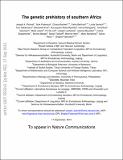The genetic prehistory of southern Africa
Author(s)
Pickrell, Joseph K.; Patterson, Nick; Barbieri, Chiara; Berthold, Falko; Gerlach, Linda; Güldemann, Tom; Kure, Blesswell; Mpoloka, Sununguko Wata; Nakagawa, Hirosi; Naumann, Christfried; Lipson, Mark; Loh, Po-Ru; Lachance, Joseph; Mountain, Joanna; Bustamante, Carlos D.; Berger, Bonnie; Tishkoff, Sarah A.; Henn, Brenna M.; Stoneking, Mark; Reich, David; Pakendorf, Brigitte; ... Show more Show less
DownloadBerger_The genetic prehistory.pdf (2.789Mb)
OPEN_ACCESS_POLICY
Open Access Policy
Creative Commons Attribution-Noncommercial-Share Alike
Terms of use
Metadata
Show full item recordAbstract
Southern and eastern African populations that speak non-Bantu languages with click consonants are known to harbour some of the most ancient genetic lineages in humans, but their relationships are poorly understood. Here, we report data from 23 populations analysed at over half a million single-nucleotide polymorphisms, using a genome-wide array designed for studying human history. The southern African Khoisan fall into two genetic groups, loosely corresponding to the northwestern and southeastern Kalahari, which we show separated within the last 30,000 years. We find that all individuals derive at least a few percent of their genomes from admixture with non-Khoisan populations that began ~1,200 years ago. In addition, the East African Hadza and Sandawe derive a fraction of their ancestry from admixture with a population related to the Khoisan, supporting the hypothesis of an ancient link between southern and eastern Africa.
Description
Author manuscript September 17, 2012
Date issued
2012-10Department
Massachusetts Institute of Technology. Computer Science and Artificial Intelligence Laboratory; Massachusetts Institute of Technology. Department of MathematicsJournal
Nature Communications
Publisher
Nature Publishing Group
Citation
Pickrell, Joseph K., Nick Patterson, Chiara Barbieri, Falko Berthold, Linda Gerlach, Tom Güldemann, Blesswell Kure, et al. “The genetic prehistory of southern Africa.” Nature Communications 3 (October 16, 2012): 1143.
Version: Author's final manuscript
ISSN
2041-1723